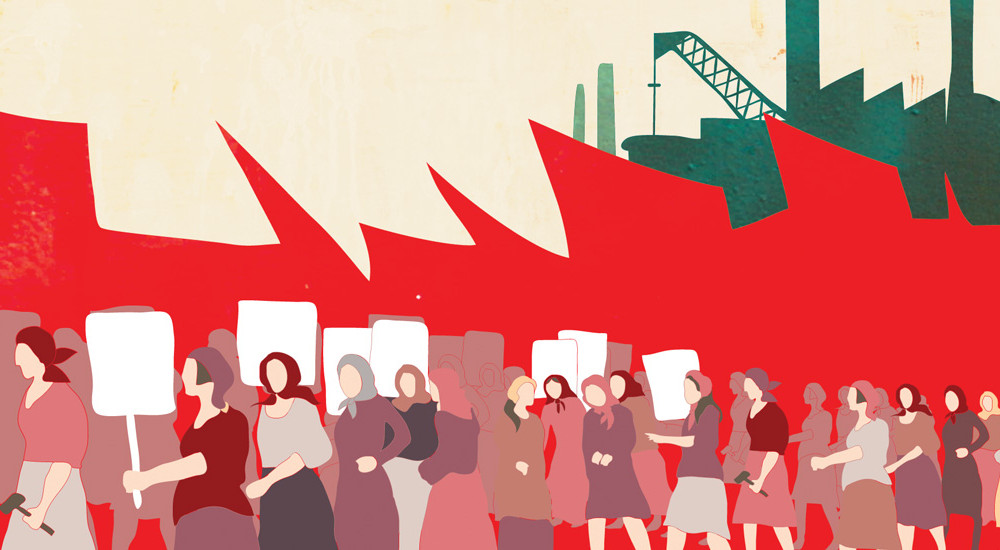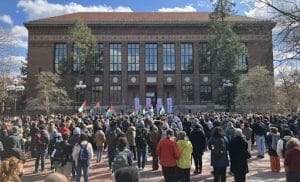Image: Ideas de Izquierda
Marcel van der Linden is Senior Researcher at the International Institute of Social History in Amsterdam, widely recognized for his work on global labor history. In this interview, Ideas de Izquierda speaks with Van der Linden about Marx’s conceptualization of the working class and Van der Linden’s efforts to build on this theory with the idea of “subaltern workers.” He discusses the challenges of posed by rethinking the current conditions and future of the “global proletariat” as a key element in strategies for contending power.
Author: Paula Varela
Could you briefly describe your earlier years as an intellectual your commitment to the study of the working class and labor movement? Was this interest related to any political involvement? How are both spheres articulated?
As is not unusual for people of my generation, my interest in workers and labor movements began during the global protest waves of the late 1960s and early 1970s. In 1973 I joined a Dutch political group called “Proletarian Left” which was partly inspired by the ideas of Marxists like Ernest Mandel who emphasized the interconnectedness of rebellions in the West (Paris ’68), the East (Prague ’68) and the South (the Tet Offensive in Vietnam). I became an academic labor historian later, in the early eighties. But the original radical inspiration has always remained important for me. I would still argue that workers’ struggles and workers’ organizations are of central importance for all efforts to build a new society based on equality and justice.
In recent years, there has been a renewed interest by social scientists in various countries on the topic of workers and labor. Some examples include your book, Workers of the World, the increasing interest in “union revitalization,” and the emergence of associations like Strikes and Social Conflicts. What do you make of this change?
This renewed interest is not a general phenomenon, I believe. In Northern Europe (Germany, Britain, the Netherlands, Scandinavia) there is, for example, less interest in this than in some other parts of the world such as South America, Southern Africa, or India. The reason for the new interest is obvious: the global economic crisis and the growth of workers’ struggles in parts of the world. At the same time it is clear that the growth of working-class resistance is not matched by a growth of traditional labor movements (trade unions, etc.). According to the International Trade Union Confederation, the umbrella organization for the majority of trade unions worldwide, only seven percent of the world working class is organized and this percentage is not increasing.
The renewed importance of these issues seems to run parallel to a return to Marx and a growth of the political left. What is your view on this? How do you see the relationship between labor scholars, the left (social and political), and Marxism?
Maybe you are more optimistic than I am. To be honest, I only see a growth of the political left in relatively small parts of the world. The ‘moderate’ left (e.g. Social Democracy) is in crisis almost everywhere. Communist Parties are certainly not doing well either, except perhaps in South Africa or the Philippines. Witness the historic defeat of the CPI-M in Bengal. The Brazilian PT has quickly adapted to neoliberalism. The revolutionary left is weak in most countries. The left has a serious problem, which also became visible in the Occupy movement: we have no address for many of our demands. The declining power of national governments makes it very difficult for states to develop their own economic policies, as was still possible in the 1950s and ‘60s. But there is also no ‘supra-state’ taking over traditional tasks of national governments, to which demands could be addressed. This vacuum on the ‘top’ is the reason why so many social-movement demands can only be negative: “we do not want X or Y”, but it is extremely difficult to develop a convincing positive alternative. Left-wing scholars in general should lay the conceptual and theoretical foundations for a global planned economy based on grassroots (direct) democracy – more as less as a radical alternative to Friedrich von Hayek’s Mont Pèlerin Society for neoliberalism earlier on. This means, on the one hand, the thorough and critical analysis of current problems (agriculture, environment, women’s rights, unemployment, and so on), and on the other hand the definition of policy procedures and instruments that could lead to the solution of these problems. Marx will undoubtedly be a major inspiration in this effort, but at the same ‘Marxism’ has many shortcomings, as my friend Karl Heinz Roth and I have argued in our recent book Beyond Marx (Leiden: Brill, 2013).
In my opinion, one of the features of the renewal of labor studies is the crisis of the “social movements paradigm.” It seems to me that for decades, social scientists hoped that these movements could challenge neoliberalism in a “post-industrial society.” Now, with evidence that these movements could not defeat neoliberalism—and with the growth of the salaried working class—the debate has shifted. Scholars today are focusing again on workers, but the working class is being portrayed as powerless, lacking the capacity for social revolution that Marx envisioned. What are your thoughts on this?
I agree with you that the social movements paradigm is in crisis. Theoretically it has exhausted itself, after an early productive phase during which some interesting and important insights were articulated (the concept of ‘resource mobilization’ for example is also very useful for labour historians). The majority of the social scientists studying movements (especially what they called ‘new social movements’) worked on the assumption that ‘old’ movements were finished, and that the new social movements expressed a ‘post-materialist’ logic. Since these scientists lacked (and lack) a serious historical approach, they didn’t see that labour movements have in the past known similar ‘expressive’ politics as new social movements in the 1970s and ‘80s.
As I said before, the working class is central to any project of major social change. But there is a problem here, that we have to face honestly. Workers’ rebellions have played a major role in societies where capitalism was not yet fully developed. The Russian October Revolution is of course the best known example, but we can also think of the Iranian Revolution of 1979 and similar dramatic power-shifts. But there have been no succesful revolutions, led by the working class, in advanced capitalist countries (unless we would consider ‘communist’ Eastern Europe as such, which I do not). The German Revoluton of 1918-19 came close, and according to many (but not according to myself), France 1968 too. The reason probably is, as Wayne Thorpe and I argued in our book Revolutionary Syndicalism: An International Perspective (1990), the evolution of the benefits of the interventionist state, that is the enormous increase in the importance of the collectively useful functions of public administration in the daily life of the people. In addition to the welfare state there have been the integrating effects of advanced capitalist relations of production and consumption (sometimes misleadingly called ‘Fordist’) whereby working-class families not only produce and reproduce labour power for sale, but operate simultaneously as units of individualized mass consumption, purchasing many of the consumer goods they produce within a system that permits capital to expand and workers’ material standards of living to improve. Only under conditions of strong immiseration, with public administrations collapsing and mass consumption being undermined, would it be possible for the working class in highly-developed capitalist societies to develop a revolutionary potential.
In your book, you propose to rebuild the enterprise of labor history by abandoning Marx’s notion of the working class and replacing it with the notion of subaltern workers. I would like to raise a theoretical question and an empirical question in response to your proposal. In terms of theory, I believe that there are many “intermediate conditions” described in Marx’s Capital, similar to the ones that you mention in your book (including domestic work and slavery, among others). In my view, Marx analyzes the development of these categories as part of the contradictory process of emergence of wage work. He describes these hybrid forms as part of the unequal development of global capitalism. Do you think the treatment of these issues in Marx’s Capital do not address the criticism that his analysis excludes “grey activities,” or that the presence of these activities today refute the concept of the proletariat?
I believe that there is a more fundamental problem. Let me use the example of chattel slavery to explain. As is well known, Marx engaged with issues related to slave labor in many passages of his work. Marx was more aware of the contrast between ‘free’ wage labor and slavery than most 21st century Marxists. As an expert on European antiquity and as a contemporary to the American Civil War, Marx was very much aware of the slavery problem. The first volume of Capital was published two years after the abolition of slavery in the United States in 1865 and 21 years before it was officially proclaimed in Brazil. Marx considered slavery a historically backward mode of exploitation that would soon be a thing of the past, as ‘free’ wage labor embodied the capitalist future. He compared the two labor forms in several writings. He certainly saw similarities between them – both produced a surplus product and ‘the wage-laborer, just like the slave, must have a master to make him work and govern him.’ At the same time, he distinguished some differences that overshadowed all the common experiences they shared. Let me offer some brief critical comments on them and indicate my doubts.
First: wage workers dispose of labor capacity, viz. ‘the aggregate of those mental and physical capabilities existing in the physical form, the living personality, of a human being, capabilities which he sets in motion whenever he produces a use-value of any kind’ – and this labor capacity is the source of value; the capitalist purchases this labor capacity as a commodity, because he expects it to provide him with a ‘specific service’, namely the creation of ‘more value than it has itself’. The same is not true of the slave’s labor capacity. The slaveholder ‘has paid cash for his slaves’, and so ‘the product of their labor represents the interest on the capital invested in their purchase.’ But since interest is nothing but a form of surplus value, according to Marx, it would seem that slaves would have to produce surplus value. And it is a fact that the sugar plantations on which slave labor was employed yielded considerable profits, because the commodity sugar embodied more value than the capital invested by the plantation owner (ground rent, amortization of the slaves, amortization of the sugar cane press etc.). So is it really the case that only the wage worker produces the equivalent of his/her own value plus ‘an excess, a surplus-value’? Or is the slave a ‘source of value’ as well?
Second: Marx states that labor power can ‘appear on the market as a commodity only if, and in so far as, its possessor, the individual whose labor-power it is, offers it for sale or sells it as a commodity. In order that its possessor may sell it as a commodity, he must have it at his disposal, he must be the free proprietor of his own labor-capacity, hence of his person.’ The future wage worker and the money owner ‘meet in the market, and enter into relations with each other on a footing of equality as owners of commodities, with the sole difference that one is a buyer, the other a seller; both are therefore equal in the eyes of the law.’ In other words: labor power should be offered for sale by the person who is the carrier and possessor of this labor power and the person who sells the labor power offers it exclusively. Why should that be so? Why can the labor power not be sold by someone other than the carrier, as for example in the case of children who are made to perform wage labor in a factory by their parents? Why can the person who offers (his or her own, or someone else’s) labor power for sale not sell it conditionally, together with means of production? And why can someone who does not own his own labor power nevertheless sell this labor power, as in the case of rented slaves, whose owners provide them to someone else for a fee?
Third: the wage worker embodies variable capital. ‘It both reproduces the equivalent of its own value and produces an excess, a surplus value, which may itself vary, and be more or less according to circumstances. This part of capital is continually being transformed from a constant into a variable magnitude. I therefore call it the variable part of capital, or more briefly, variable capital.’ ‘It is only because labor is presupposed in the form of wage-labor, and the means of production in the form of capital (i.e. only as a result of this specific form of these two essential agents of production), that one part of the value (product) presents itself as surplus-value and this surplus-value presents itself as profit (rent), the gains of the capitalist, as additional available wealth belonging to him.’ To Marx, the slave is part of fixed capital and no different, economically, from livestock or machinery. ‘The slave-owner buys his worker in the same way as he buys his horse.’ The slave’s capital value is his purchasing price, and this capital value has to be amortized over time, just as with livestock and machinery. But how justified is Marx in defining only wage labor as variable capital, on the grounds that ‘this part of capital’ can ‘be more or less’? Is the same not true of commodity-producing slave labor?
Fourth: when the wage worker produces a commodity, this commodity is ‘a unity formed of use-value and value’, for which reason ‘the process of production must be a unity, composed of the labor process and the process of creating value [Wertbildungsprozess].’ No one will doubt that slaves producing cane sugar, tobacco or indigo are producing commodities, just like wage workers. But if this is the case, then slaves also produce value. Marx denies this, since he considers slaves part of constant capital and holds that only variable capital creates value.
Fifth: the wage worker always divests himself of his labor power ‘for a limited period only, for if he were to sell it in a lump, once and for all, he would be selling himself, converting himself from a free man into a slave, from an owner of a commodity into a commodity.’ Normally, one would refer to such a transaction (the ‘sale’ of a commodity in installments, without any change of owner) as a lease and not as a sale – an obvious idea that was already formulated much earlier. The distinction between a lease and a sale may appear insignificant, but it is not. ‘When a sales contract is closed, the substance of the commodity becomes the property of the other party, whereas when a lease contract is closed, the other party merely purchases the right to use the commodity; the seller only makes his commodity available temporarily, without relinquishing ownership of it’, as Franz Oppenheimer has rightly noted. When A sells B a commodity, B becomes the owner in lieu of A. But when A leases B a commodity, A remains the owner and B merely receives the right to use the commodity for a fixed term. The ‘substance’ of the commodity remains with A, whereas B receives its ‘use and enjoyment’. Thus, if wage labor is the leasing of labor power, the difference between a wage worker and a slave does not consist in the ‘definite period of time’ for which labor power is made available, but in the fact that in one case, labor power is leased, while in the other it is sold. Why do we not find this consideration in Marx? Presumably because it makes the process of value creation appear in a different light. The substance of the value of labor power is retained by the worker rather than being yielded to the capitalist. Engels held that lease transactions are ‘only a transfer of already existing, previously produced value, and the total sum of values possessed by the landlord and the tenant together remains the same after as it was before.’ Thus if wage labor were a lease relation as well, it could not create surplus value.
Sixth: according to Marx, the rate of profit tends to decline because the social productivity of labor increases constantly: ‘Since the mass of living labor applied continuously declines in relation to the mass of objectified labor that sets it in motion, i.e. the productively consumed means of production, the part of this living labor that is unpaid and objectified in surplus-value must also stand in an ever-decreasing ratio to the value of the total capital applied.’ The endpoint of this tendency would of course be a situation in which variable capital has been reduced to zero and total capital consists exclusively of constant capital. In such a situation, the collapse of capitalism would be a fact. But the odd thing is that there already existed such a terminal phase prior to the industrial revolution, namely on the plantations of the 17th and 18th centuries. These plantations employed slave labor, so that according to Marx’s premises, total capital consisted exclusively of constant capital. How are we to account for the economic dynamism of the plantations on this basis?
The example of slave labor shows Marx did not provide a consistent justification for the privileged position productive wage labor is given within his theory of value. There is much to suggest that slaves and wage workers are structurally more similar than Marx and traditional Marxism suspected. The historical reality of capitalism has featured many hybrid and transitional forms between slavery and ‘free’ wage labor. Moreover, slaves and wage workers have repeatedly performed the same work in the same business enterprise. It is true, of course, that the slave’s labor capacity is the permanent property of the capitalist, whereas the wage worker only makes his labor capacity available to the capitalist for a limited time, even if he does so repeatedly. It remains unclear, however, why slaves should create no surplus value while wage workers do. The time has come to expand the theory of value in such a way as to recognize the productive labor of slaves and other unfree workers as an essential component of the capitalist economy.
The empirical question: If there are only differences in degree between different ways of commodifying labor, how do you explain the historical imposition of free waged labor and its contemporary prevalence among the multitude? Although you pose this question in the book, I did not find a suitable answer. One possible explanation for the lack of an answer is your re-conceptualization of the notion of worker based exclusively in the sphere of exchange, thus abandoning the distinction between the product of labor and the labor force, which is key to understanding Marx’s theory of surplus labor. What is your response? Can you clarify your concept of worker?
The historical imposition of ‘free’ waged labor cannot be explained through its supposed high productivity. I argue in Workers of the World and elsewhere, that empirical history shows that slave labor can also be highly productive and technically sophisticated, on the condition that the treatment of the slaves is improved. From a capitalist point of view, mass slavery has, however, one important weak spot: it reduces mass consumption. Marx characterized the difference between slave and wage worker as follows:
“The slave receives the means of subsistence he requires in the form of naturalia which are fixed both in kind and quantity – i.e. he receives use-values. The free worker receives them in the shape of money, exchange-value, the abstract social form of wealth. […] It is the worker himself who converts the money into whatever use-values he desires; it is he who buys commodities as he wishes and, as the owner of money, as the buyer of goods, he stands in precisely the same relationship to the sellers of goods as any other buyer.”
Slaves therefore are largely outside the commodity system as consumers, and therefore do not permit the full development of an internal market. Wage earners by contrast could be integrated in an upward spiral of rising wages and increasing mass consumption. In other words: twentieth century capitalism based on mass consumption was only possible thanks to the growing buying power of the working classes in the metropoles. In fact, wage labor in the metropoles was, from this point of view, a conditio sine qua non for advanced capitalist prosperity. The explanation of the rise of ‘free’ wage labor can only be found in the sphere of circulation.
At the same time, I would strongly object to your suggestion that my re-conceptualization of the worker is based exclusively in the sphere of exchange, and abandons the distinction between labor and labor-power (the capacity to labor). Both the labor-power of the slave and the labor-power of the ‘free’ wage earner are commodified, and both produce in my view surplus labor and often surplus value. As I said above, the distinction between them lies in the hiring out and the selling of labor power, not in the selling for a short while or forever.
Your book analyzes the relationship between “subaltern workers” and their forms of organization and collective struggle. In the Marxist tradition, the social condition of the proletariat determined its collective organizations and struggles, but in the case of subaltern workers this determination is eliminated. Some readers could argue that there is a contradiction in the book between trying to recover labor as the social component of the multitude and at the same time denying the relationship of determination between social position and political action. What is your response to this critique? It seems that when you try to avoid economicism, you may end up introducing the autonomy of political action. This leaves one question unanswered: How can subaltern workers bring an end to their subaltern condition?
Why do you think that the social condition of subaltern workers does not determine its collective organizations and struggles? You give no arguments. In fact, I would say that according to the Marxist tradition it is true for all social classes that their collective organizations and struggles are determined by their social condition. Probably your question is inspired by a very specific notion of the working class, an old-fashioned one, which considers only wage earners in agriculture, industry, mining and transport as the ‘real’ working class. But think, for example, of domestic servants. Are they not also wage earners and part of the working class? And do you know significant examples of joint struggles of e.g. industrial workers and domestic servants? Probably not. The working class in the traditional Marxist sense was never as homogeneous as is often supposed. I expand the notion of the working class to include sharecroppers, chattel slaves, etc. thereby on the one hand further increasing the heterogeneity of the class, but on the other hand opening the possibility for discovering other forms of intra-class alliances that older analyses have neglected, e.g. joint struggles of slaves and sailors (as described in the magnificent The Many-Headed Hydra of Peter Linebaugh and Marcus Rediker (2000)), of sharecroppers and wage earners, and so on. The danger of posing the question like you do is that of letting one’s analysis be guided by political wishful thinking instead of a materialist analysis of relations of production.
What we see now is a certain convergence of living and working conditions of workers on a global scale. The so-called Standard Employment Relation in OECD countries is gradually broken down and it seems to become even more a male privilege than it was previously. The destruction proceeds step by step, but rather consistently so. The labor relations in rich countries are therefore beginning to look much more like those of poor countries. Precarization is a global trend. The current demolition of ‘social capitalism’ confirms an insight about long-term developments, which István Mészáros has stated as follows:
“The objective reality of different rates of exploitation – both within a given country and in the world system of monopoly capital – is as unquestionable as are the objective differences in the rates of profit at any particular time […]. All the same, the reality of the different rates of exploitation and profit does not alter the fundamental law itself: i.e. the growing equalization of the differential rates of exploitation as the global trend of development of world capital.”
The fierce, increasingly global competition between capitals now has a clear downward ‘equalizing’ effect on the quality of life and work in the more developed parts of global capitalism. New forms of resistance and organization are developing, and a major question is whether the traditional trade unions will be able to change themselves and become attractive partners for the new social forces, or whether they will decline further and become obsolete.










